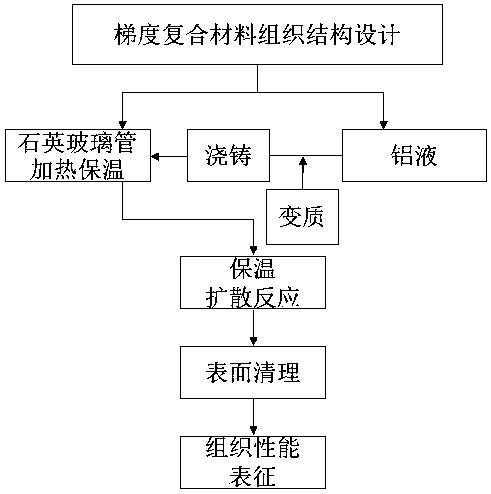In-situ authigenic aluminum-silicon gradient composite material and preparing method thereof
A composite material, in-situ self-generating technology, applied in electrical components, circuits, electrical solid devices, etc., can solve the problems of life reduction and electronic device failure rate increase, and achieve easy processing, high wear resistance, and application prospects. expansive effect
- Summary
- Abstract
- Description
- Claims
- Application Information
AI Technical Summary
Problems solved by technology
Method used
Image
Examples
Embodiment 1
[0038] (1) Place the high-purity silica quartz glass vessel with the same workpiece shape in a heating furnace and heat it to 800 o C preheating and heat preservation;
[0039] (2) will be 800 o C pure aluminum liquid is poured into step (1) in the high-purity silica quartz glass vessel, leaves standstill at 800 o C insulation;
[0040] (3) Control the holding time of step (2) for 2 hours to ensure that the aluminum liquid and silicon dioxide react, the silicon atoms diffuse into the aluminum liquid, and finally cool with the furnace;
[0041] (4) Removing the residual quartz glass on the surface of the material in step (3) to obtain an in-situ self-generated aluminum-silicon gradient composite material consistent with the shape of the quartz glass vessel.
[0042] (5) Macro organization see figure 2 , massive primary silicon is distributed in the outer ring; the mosaic diagram of the microstructure from outside to inside image 3 , it can be clearly seen that the layere...
Embodiment 2
[0044] (1) Place the high-purity silica quartz glass vessel with the same workpiece shape in a heating furnace and heat it to 800 o C preheating and heat preservation;
[0045] (2) Melt high-purity aluminum in a high-purity aluminum oxide ceramic crucible, and add 3wt.% lanthanum to the aluminum liquid.
[0046] (3) Step (2) molten aluminum is heated to 800 o C is poured into step (1) in the high-purity silica quartz glass vessel, leaves standstill at 800 o C insulation;
[0047] (4) Control the holding time of step (3) for 2 hours to ensure that the aluminum liquid and silicon dioxide react, and the silicon atoms diffuse into the aluminum liquid, and finally cool with the furnace;
[0048] (5) Removing the residual quartz glass on the surface of the material in step (4) to obtain an in-situ self-generated aluminum-silicon gradient composite material consistent with the shape of the quartz glass vessel.
[0049] (6) See macro organization chart Figure 5 (The white spots ...
Embodiment 3
[0051] (1) Place the high-purity silica quartz glass vessel with the same workpiece shape in a heating furnace and heat it to 800 o C preheating and heat preservation;
[0052] (2) Melt high-purity aluminum in a high-purity aluminum oxide ceramic crucible, and add 1.00wt.% cerium to the aluminum liquid.
[0053] (3) Step (2) molten aluminum is heated to 800 o C is poured into step (1) in the high-purity silica quartz glass vessel, leaves standstill at 800 o C insulation;
[0054] (4) Control the holding time of step (3) for 2 hours to ensure that the aluminum liquid and silicon dioxide react, and the silicon atoms diffuse into the aluminum liquid, and finally cool with the furnace;
[0055] (5) Removing the residual quartz glass on the surface of the material in step (4) to obtain an in-situ self-generated aluminum-silicon gradient composite material consistent with the shape of the quartz glass vessel.
[0056] (6) See macro organization chart Figure 7 (The white spots ...
PUM
| Property | Measurement | Unit |
|---|---|---|
| density | aaaaa | aaaaa |
| microhardness | aaaaa | aaaaa |
Abstract
Description
Claims
Application Information
 Login to View More
Login to View More - R&D
- Intellectual Property
- Life Sciences
- Materials
- Tech Scout
- Unparalleled Data Quality
- Higher Quality Content
- 60% Fewer Hallucinations
Browse by: Latest US Patents, China's latest patents, Technical Efficacy Thesaurus, Application Domain, Technology Topic, Popular Technical Reports.
© 2025 PatSnap. All rights reserved.Legal|Privacy policy|Modern Slavery Act Transparency Statement|Sitemap|About US| Contact US: help@patsnap.com



